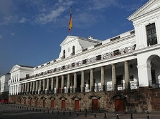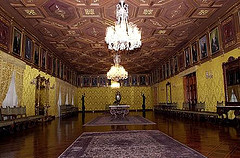
Palacio de Carondelet
Encyclopedia
Carondelet Palace is the seat of government of the Republic of Ecuador
, located in the historical center of Quito
. Axis is the nerve of the public space known as Independence Square or Plaza Grande (colonial name), around which were built in addition the Archbishop's Palace, the Municipal Palace, the Hotel Plaza Grande
and the Metropolitan Cathedral.
Juan Fernandez de Recalde, president of the Audience then informed the king that the building was finished, and it was purchased by the Crown as a larger building to house the comfortable premises of the Spanish Administration in Quito soil.
Some time later, the successor to President Recalde, Antonio de Morga, informed the king that the royal houses were unworthy to carry that name, because they were close and very old, so they proposed to buy the adjacent houses. The earthquake of 1627 forced them to buy the neighboring buildings that, by their age, were rebuilt in stone and brick. Thereafter, the power of the audience settled in front of the Plaza Grande.
was appointed chairman of the hearing. In 1801, the Spanish engaged to Antonio Garcia, under his direction, perform work of rehabilitation and improvements, both at the Palace of the audience at the Cathedral as well; also led the work on the arches of the sewers and the renovation of the Prison building.
After the independence of Ecuador, culminated with the Battle of Pichincha
in 1822, the palace became the headquarters of the South Department of Gran Colombia
, receiving the liberator Simón Bolívar
sometimes, whom wondered by the elegance and austerity of the building in addition to being delighted with the taste of the Baron of Carondelet (main thrust of the work), so it was Bolivar who gave the name of Carondelet Palace.
 During the Republican era, almost all the presidents (constitutional, internees and dictators) have dispatched from this building, which is the seat of Government of the Republic of Ecuador.
During the Republican era, almost all the presidents (constitutional, internees and dictators) have dispatched from this building, which is the seat of Government of the Republic of Ecuador.
There has been some changes over the years, the most important in the presidencies of Gabriel García Moreno
, Camilo Ponce Enríquez and Sixto Durán Ballén
.
In addition to the administrative units in the third level of the Palace is the presidential residence, a luxurious colonial-style apartment in which they live the President and his family.
Currently, the Presidency and Vice Presidency of the Republic and the Ministry of Government, occupy the Complex of Carondelet, which includes the buildings of the former Mail (current Benalcázar street, between Chile and Espejo) and the Government Palace, separated by the garage.
, president since 2007, considering that Carondelet Palace and its agencies are Ecuadoran heritages, convert the presidential compound into a museum accessible to all who wish to visit it.
To this end, areas were organized to locate objects within their cultural contexts, to make them accessible to the world, which used several rooms and spaces within the palace.
To make this work, Maria del Carmen Molestina researcher, Ph.D. in Archeology Museum and former director of the Central Bank of Ecuador, made the inventory and identified places to expose the gifts that President Correa received from their possession. Furthermore, the found objects and antique furniture from the Palace to put on cultural value and entering the exhibition gallery.
Under this system, is now the opportunity to give gifts to all his presidential value cultural, historical and / or ethnographic, as are all objects that represent and embody habits, traditions, ideologies and thoughts of different Ecuadoria ethnic groups.
The finding that the expert has done, made to establish how long the place was "looting"; doing a bit of history, the Carondlet Palace was restored in the presidency of Camilo Ponce Enríquez, and until the presidency of León Febres-Cordero Ribadeneyera
, everything was perfectly fine. From that period is not known about the fate of the various possessions of the Presidential House.
Additionally, Molestina assumes that everything is kept until the presidency of Rodrigo Borja, just prior to Sixto Durán Ballen perform the presidential apartment suitable in the third level.
Ecuador
Ecuador , officially the Republic of Ecuador is a representative democratic republic in South America, bordered by Colombia on the north, Peru on the east and south, and by the Pacific Ocean to the west. It is one of only two countries in South America, along with Chile, that do not have a border...
, located in the historical center of Quito
Quito
San Francisco de Quito, most often called Quito , is the capital city of Ecuador in northwestern South America. It is located in north-central Ecuador in the Guayllabamba river basin, on the eastern slopes of Pichincha, an active stratovolcano in the Andes mountains...
. Axis is the nerve of the public space known as Independence Square or Plaza Grande (colonial name), around which were built in addition the Archbishop's Palace, the Municipal Palace, the Hotel Plaza Grande
Hotel Plaza Grande
Hotel Plaza Grande is a five-star luxury hotel in the historic centre of Quito, Ecuador. The hotel is located next to the Carondelet Palace and the Archbishop's Palace and faces the Old Town's eponymous central plaza, Plaza de la Independencia...
and the Metropolitan Cathedral.
History
The history of this emblematic building dating back to colonial times, around 1570, with the acquisition of the former royal houses located in the city of Quito.First Royal Houses
The first seat of the Spanish Crown in the Audience of Quito functioned near the convent of La Merced (current Cuenca and Chile streets) until around the year 1611, when dies Diego Suarez de Figueroa, secretary of the audience, who owned a small palace built in the central square (Plaza Grande).Juan Fernandez de Recalde, president of the Audience then informed the king that the building was finished, and it was purchased by the Crown as a larger building to house the comfortable premises of the Spanish Administration in Quito soil.
Some time later, the successor to President Recalde, Antonio de Morga, informed the king that the royal houses were unworthy to carry that name, because they were close and very old, so they proposed to buy the adjacent houses. The earthquake of 1627 forced them to buy the neighboring buildings that, by their age, were rebuilt in stone and brick. Thereafter, the power of the audience settled in front of the Plaza Grande.
The New Palace
In 1799, the Barón Francisco Luis Héctor de CarondeletFrancisco Luis Hector de Carondelet
Francisco Luis Hector, barón de Carondelet was an administrator of Burgundian descent in the employ of the Spanish Empire. He was a Knight of Malta....
was appointed chairman of the hearing. In 1801, the Spanish engaged to Antonio Garcia, under his direction, perform work of rehabilitation and improvements, both at the Palace of the audience at the Cathedral as well; also led the work on the arches of the sewers and the renovation of the Prison building.
After the independence of Ecuador, culminated with the Battle of Pichincha
Battle of Pichincha
The Battle of Pichincha took place on 24 May 1822, on the slopes of the Pichincha volcano, 3,500 meters above sea-level, right next to the city of Quito, in modern Ecuador....
in 1822, the palace became the headquarters of the South Department of Gran Colombia
Gran Colombia
Gran Colombia is a name used today for the state that encompassed much of northern South America and part of southern Central America from 1819 to 1831. This short-lived republic included the territories of present-day Colombia, Venezuela, Ecuador, Panama, northern Peru and northwest Brazil. The...
, receiving the liberator Simón Bolívar
Simón Bolívar
Simón José Antonio de la Santísima Trinidad Bolívar y Palacios Ponte y Yeiter, commonly known as Simón Bolívar was a Venezuelan military and political leader...
sometimes, whom wondered by the elegance and austerity of the building in addition to being delighted with the taste of the Baron of Carondelet (main thrust of the work), so it was Bolivar who gave the name of Carondelet Palace.
The Republican Carondelet

There has been some changes over the years, the most important in the presidencies of Gabriel García Moreno
Gabriel García Moreno
Gabriel Gregorio Fernando José María García y Moreno y Morán de Buitrón was an Ecuadorian statesman who twice served as President of Ecuador and was assassinated during his second term, after being elected to a third term...
, Camilo Ponce Enríquez and Sixto Durán Ballén
Sixto Durán Ballén
Sixto Alfonso Durán-Ballén Cordovez is an U.S.-born Ecuadorian political figure and architect. He served as Mayor of Quito between 1970 and 1978, and as president of Ecuador between 1992 and 1996...
.
In addition to the administrative units in the third level of the Palace is the presidential residence, a luxurious colonial-style apartment in which they live the President and his family.
Currently, the Presidency and Vice Presidency of the Republic and the Ministry of Government, occupy the Complex of Carondelet, which includes the buildings of the former Mail (current Benalcázar street, between Chile and Espejo) and the Government Palace, separated by the garage.
Opening to the Public
Rafael CorreaRafael Correa
Rafael Vicente Correa Delgado born is the President of the Republic of Ecuador and was the president pro tempore of the Union of South American Nations. An economist educated in Ecuador, Belgium and the United States, he was elected President in late 2006 and took office in January 2007...
, president since 2007, considering that Carondelet Palace and its agencies are Ecuadoran heritages, convert the presidential compound into a museum accessible to all who wish to visit it.
To this end, areas were organized to locate objects within their cultural contexts, to make them accessible to the world, which used several rooms and spaces within the palace.
To make this work, Maria del Carmen Molestina researcher, Ph.D. in Archeology Museum and former director of the Central Bank of Ecuador, made the inventory and identified places to expose the gifts that President Correa received from their possession. Furthermore, the found objects and antique furniture from the Palace to put on cultural value and entering the exhibition gallery.
Under this system, is now the opportunity to give gifts to all his presidential value cultural, historical and / or ethnographic, as are all objects that represent and embody habits, traditions, ideologies and thoughts of different Ecuadoria ethnic groups.
Plunder of the Palace
According to the researcher Maria del Carmen Molestina it is amazing how, over the years, the Palace of Carondelet has been plundered. Most of the furniture and items that can be seen today are new, even have drawn some of the brass fittings of the furniture from the time of Garcia Moreno, placing replicas in gold spray lead.The finding that the expert has done, made to establish how long the place was "looting"; doing a bit of history, the Carondlet Palace was restored in the presidency of Camilo Ponce Enríquez, and until the presidency of León Febres-Cordero Ribadeneyera
León Febres Cordero
León Esteban Febres-Cordero Ribadeneyra was President of Ecuador for a four-year term from 10 August 1984 to 10 August 1988...
, everything was perfectly fine. From that period is not known about the fate of the various possessions of the Presidential House.
Additionally, Molestina assumes that everything is kept until the presidency of Rodrigo Borja, just prior to Sixto Durán Ballen perform the presidential apartment suitable in the third level.

